From Flanders to Portugal: A Portuguese Painter in Pursuit of Prestigious Flemish Painting—Materials and Techniques Compared Through an Analytical Approach
Abstract
1. Introduction
2. Materials and Methods
3. Results and Discussion
3.1. Supports
3.2. Ground Layers
3.3. Drawing and Priming Layers
- An initial geometric layout establishing the placement of figures and architectural elements.
- A refined contour drawing of the figures.
- A final, fluid application of carbon-based medium with brush and pen, executed with great precision to faithfully replicate P1.
3.4. Gold Leaf and Bolus
3.5. Pigments and Layering
3.5.1. White Color
3.5.2. Yellow Color
3.5.3. Red Color
3.5.4. Brown Color
3.5.5. Green Color
3.5.6. Blue Color
3.5.7. Gray Color
3.5.8. Black Color
3.5.9. Flesh Tone
4. Conclusions
Author Contributions
Funding
Data Availability Statement
Acknowledgments
Conflicts of Interest
| 1 | The Portuguese feitoria in Flanders was an official Crown-sanctioned trading post, initially established in Bruges and later relocated to Antwerp during the 15th and 16th centuries. It served as a structured node within Portugal’s overseas commercial network, facilitating trade in goods such as spices, sugar, and wine, and ensuring diplomatic and fiscal coordination with the merchant economies of Northern Europe. |
References
- Nichols, J.G. XXVIII.—Remarks on some Pictures of Quintin Matsys and Holbein, in the Collection of the Earl of Radnor, at Longford Castle. Archaeologia 1874, 44, 435–458. [Google Scholar] [CrossRef]
- Jongen, L.; Boëllet, N. Wanneer het God behaagt, Voortgang. Neerlandistiek VU Foundation, Amsterdam. Progress 2009, 27, 26–45. [Google Scholar]
- Filedt Kok, J.P.; Bruijnen, Y.; Bikker, J. Early Netherlandish paintings in the Rijksmuseum, Amsterdam. Artists born before 1500. Bus. Strategy Environ. 2009, 1. [Google Scholar]
- Woodall, J. De wisselaer: Quentin Matsys’s Man weighing gold coins and his wife. Neth. Yearb. Hist. Art/Ned. Kunsthist. Jaarb. Online 2014, 63, 38–75. [Google Scholar] [CrossRef]
- Born, A.; Martens, M. O políptico de Quinten de Metsys para o convento da Madere de Deus: Notas sobre a técnica. In Casa Perfeitíssima: 500 anos da Fundação do Mosteiro da Madre de Deus, Museu Nacional do Azulejo, Ministério da Cultura; Curvelo, A., Ed.; Instituto dos Museus e da Conservação: Lisboa, Portugal, 2009; pp. 155–166. [Google Scholar]
- Carvalho, J.A.S. 159–Tríptico do Baptismo de Cristo. In Cristo Fonte de Esperança; Porto, D.d., Azevedo, C.A.M., Eds.; Diocese do Porto: Porto, Portugal, 2000; pp. 260–261. [Google Scholar]
- Dunkerton, J. The Technique and Restoration of ‘The Virgin and Child Enthroned, with Four Angels’ by Quinten Massys. Natl. Gallery Tech. Bull. 2008, 29, 60–75. [Google Scholar]
- Hirsch, E.F. Damião de Gois and the Arts. In Damião de Gois; Archives Internationales d’Histoire des Idees/International Archives of the Historry of Ideas: The Hague, The Netherlands, 1967; Volume 19. [Google Scholar]
- Fouto, C. Damião de Góis’s Livro de Linhagens: An Untold (Hi)story. Port. Stud. 2015, 31, 235–249. [Google Scholar] [CrossRef]
- Lorena, M. A pintura flamenga em Portugal–os retábulos de Metsys, Morrison e Ancede. In Estudo Técnico e Material; Universidade de Évora, Museologia: Évora, Portugal, 2013. [Google Scholar]
- Lorena, M. Altarpiece painting: A view from the inside. E-Conserv. J. 2015, 3, 118–138. [Google Scholar]
- Cruz, A.J. Ser Ou Não Ser Metsys: O Desenho Subjacente Do Tríptico Da Vida De Cristo, De Tomar, e a Sua Atribuição Autoral. Artis Rev. História Arte Ciências Património 2017, 5, 104–113. [Google Scholar]
- Eires, E.A.F. O tríptico da vida de Cristo, estudo e Tratamento de Pintura Sobre Madeira da Igreja de São João Baptista, em Tomar, atribuída à oficina de Quentin Metsys. Doctoral Dissertation, IPT-Instituto Politécnico de Tomar, Tomar, Portugal, 2015. [Google Scholar]
- Cruz, A.J.; Eires, E.; Dias, L.; Desterro, T.; Rego, C. Identification of vivianite, an unusual blue pigment, in a sixteenth-century painting and its implications. Colour Res. Appl. 2018, 43, 177–183. [Google Scholar] [CrossRef]
- Pereira, F.A.B.; Batoréo, M.; Alves, A.N.; Jesus, A.; Francisco, M.J. Retábulo do Convento de Jesus de Setúbal; Câmara Municipal de Setúbal: Setúbal, Portugal, 2013. [Google Scholar]
- Caetano, J.O. Jorge Afonso, uma Interrogação Essencial na Pintura Primitiva Portuguesa. Doctoral Dissertation, Universidade de Évora, Museologia, Évora, Portugal, 2013. [Google Scholar]
- Reis-Santos, L. Jorge Afonso, coi. In Nova Colecção de Arte Portuguesa; Artis: Lisboa, Portugal, 1966. [Google Scholar]
- Flor, P. Notas sobre Jorge Afonso e o Mestre da Charola de Tomar. Artis, revista do Instituto de História da arte da Faculdade de Letras da Universidade de Lisboa. Sep. Da Rev. Artis–Rev. Do Inst. De História Da Arte Da Fac. De Let. De Lisb. 2009, 7, 73–78. [Google Scholar]
- Antunes, V.; Candeias, A.; Valadas, S. Travelling masterpieces from Flanders to Portugal: Jorge Afonso’s Portuguese “copy” of Quentin Metsys’s “Apparition of the Angel to Saints Clare, Agnes, and Colette”. In Art, Travel, and Exchange Between Iberia and Global Geographies, c.1400-1550; Beltrami, C., Alvares-Correa, S., Eds.; Brill: Leiden, The Netherlands, 2025; pp. 384–404, Chapter 12. [Google Scholar]
- Guerra, M.; Manso, M.; Longelin, S.; Pessanha, S.; Carvalho, M.L. Carvalho, Performance of three different Si X-ray detectors for portable XRF spectrometers in cultural heritage applications. J. Instrum. 14th Int. Workshop Radiat. Imaging Detect. (IWORID2012) 2012, 7, C10004. [Google Scholar]
- Guerra, M.; Manso, M.; Pessanha, S.; Longelin, S.; Carvalho, M.L. Theoretical and Experimental Study on the Angular Dependence of Scattering Processes in XRF Systems. X-Ray Spectrom. 2013, 42, 402–407. [Google Scholar] [CrossRef]
- Bell, I.M.; Clark, R.J.; Gibbs, P.J. Raman spectroscopic library of natural and synthetic pigments (pre- ≈ 1850 AD). Spectrochim. Acta Part A Mol. Biomol. Spectrosc. 1997, 53, 2159–2179. [Google Scholar] [CrossRef] [PubMed]
- Burgio, L.; Clark, R.J.H. Library of FT-Raman spectra of pigments, minerals, pigment media and varnishes, and supplement to the existing library of Raman spectra of pigments with visible excitation. Spectrochim. Acta Part A Mol. Biomol. Spectrosc. 2001, 57, 1491–1521. [Google Scholar] [CrossRef]
- Downs, R.T. The RRUFF Project: An integrated study of the chemistry, crystallography, Raman, and infrared spectroscopy of minerals. In Proceedings of the Program and Abstracts of the 19th General Meeting of the International Mineralogical Association, Kobe, Japan, 23–28 July 2006; p. 117. [Google Scholar]
- Brewer, P.W.; Murphy, D.; Jansma, E. TRiCYCLE: A universal conversion tool for digital tree-ring data. Tree-Ring Res. 2011, 67, 135–144. [Google Scholar] [CrossRef]
- Rinn, F. TSAP-Win User Reference Manual; Rinntech: Heidelberg, Germany, 2010. [Google Scholar]
- Antunes, V.; Candeias, A.; Mirão, J.; Carvalho, M.L.; Dias, C.B.; Manhita, A.; Cardoso, A.; Francisco, M.J.; Lauw, A.; Manso, M. Analytical characterization of the palette and painting techniques of Jorge Afonso, the great 16th century Master of Lisbon painting workshop. Spectrochim. Acta. Part A Mol. Biomol. Spectrosc. 2017, 193, 264–275. [Google Scholar] [CrossRef]
- Billinge, R.; Campbell, L.; Dunkerton, J.; Foister, S.; Kirby, J.; Pilc, J.; White, R. Methods and Materials of Northern European Painting in the National Gallery, 1400–1550. Natl. Gallery Tech. Bull. 1997, 18, 6–55. [Google Scholar]
- Roy, A.; Smith, P.; Bomford, D. Painting Techniques, History, Materials and Studio Practice: Contributions to the Dublin Congress, 7–11 September 1998; International Institute for Conservation of Historic and Artistic Works: London, UK, 1998. [Google Scholar]
- Antunes, V.; Candeias, A.; Coroado, J.; Serrão, V.; Cachão, M.; Carvalho, M.L. A multidisciplinary approach to the study of the brightening effects of white chalk ground layers in 15th and 16th century paintings. Anal. Methods 2016, 8, 4785–4797. [Google Scholar] [CrossRef]
- Klein, P. Dendrochronological analyses of Netherlandish panel paintings. In La Pintura Europea Sobre Tabla. Siglos XV, XVI y XVII; Ministerio de Cultura: Madrid, Spain, 2010; pp. 94–99. Available online: https://dialnet.unirioja.es/servlet/articulo?codigo=4086462 (accessed on 13 May 2025).
- Vandivere, A.L.S. From the Ground Up: Surface and Sub-Surface Effects in Fifteenth-and Sixteenth-Century Netherlandish Paintings; Faculty of Humanities, Instituut voor Cultuur en Geschiedenis: Spinhuis: Amsterdam, The Netherlands, 2013. [Google Scholar]
- Antunes, V.; Oliveira, M.J.; Vargas, H.; Serrão, V.; Candeias, A.; Carvalho, M.L.; Coroado, J.; Mirão, J.; Dias, L.; Longelin, S.; et al. Characterization of glue sizing under calcium carbonate ground layers in flemish and luso-flemish painting-analysis by SEM-EDS, µ-XRD and µ-Raman. Anal. Methods 2014, 6, 710–717. [Google Scholar] [CrossRef]
- Davies, M. Early Flemish Painting. By Margaret Whinney. 10 × 7½. Pp. 168 + 100 pls. London: Faber & Faber, 1968. 70s. Antiqu. J. 1969, 49, 168–169. [Google Scholar]
- Antunes, V. Techniques and Materials of Preparation in the Portuguese Painting of the XV and XVI Centuries. Doctoral Dissertation, Universidade de Lisboa, História, Portugal, 2014. [Google Scholar]
- Antunes, V.; Candeias, A.; Oliveira, M.J.; Lorena, M.; Seruya, A.I.; Carvalho, M.L.; Gil, M.; Mirao, J.; Coroado, J.; Gomes, V.; et al. Calcium sulphate fillers and binders in Portuguese 15th and 16th centuries: Ground layers from a family painting workshop-Study by multianalytical spectroscopic techniques. Microchem. J. 2016, 125, 290–298. [Google Scholar] [CrossRef]
- Antunes, V.; Candeias, A.; Mirão, J.; Carvalho, M.L.; Serrão, V.; Dias, C.B.; Manhita, A.; Cardoso, A.; Manso, M. On the origin of Goa Cathedral former altarpiece: Material and technical assessment to the work of Garcia Fernandes, Portuguese painter from 16th century Lisbon workshop. Microchem. J. 2018, 138, 226–237. [Google Scholar] [CrossRef]
- Antunes, V.; Candeias, A.; Mirão, J.; Serrão, V.; Dias, C.B.; Manhita, A.; Cardoso, A.; Manso, M.; Carvalho, M.L. A Painter in the Shadow: Unveiling Conservation, Materials and Techniques of the Unknown Luso-Flemish Master of Lourinhã. Heritage 2019, 4, 2725–2744. [Google Scholar] [CrossRef]
- Antunes, V.; Candeias, A.; Oliveira, M.J.; Carvalho, M.L.; Dias, C.B.; Manhita, A.; Francisco, M.J.; Costa, S.; Lauw, A.; Manso, M. Uncover the mantle: Rediscovering Gregorio Lopes palette and technique with a study on the painting “Mater Misericordiae”. Appl. Phys. A-Mater. Sci. Process. 2016, 122, 1–14. [Google Scholar] [CrossRef]
- Antunes, V.; Candeias, A.; Oliveira, M.J.; Longelin, S.; Serrão, V.; Seruya, A.I.; Coroado, J.; Dias, L.; Mirao, J.; Carvalho, M.L. Characterization of gypsum and anhydrite ground layers in 15th and 16th centuries Portuguese paintings by Raman Spectroscopy and other techniques. J. Raman Spectrosc. 2014, 45, 1026–1033. [Google Scholar] [CrossRef]
- Valadas, S.; Freire, R.V.; Cardoso, A.; Mirão, J.; Dias, C.B.; Vandenabeele, P.; Candeias, A. On the Use of the Unusual Green Pigment Brochantite (Cu4(OH)6(SO4)) in the 16th-Century Portuguese-Flemish Paintings Attributed to The Master Frei Carlos Workshop. Microsc. Microanal. 2015, 21, 518–525. [Google Scholar] [CrossRef] [PubMed]
- Morrison, E.; Kren, T. Flemish Manuscript Painting in Context: Recent Research; Getty Trust Publications: J. Paul Getty Museum Series; J. Paul Getty Museum: Los Angeles, CA, USA, 2007; p. 208. ISBN 9780892368525. [Google Scholar]
- Bomford, D.; Billinge, R.; Campbell, L.; Dunkerton, J.; Foister, S.; Kirby, J.; Plazzotta, C.; Roy, A.; Spring, M. Art in the Making: Underdrawings in Renaissance Paintings; National Gallery: Londres, UK, 2002. [Google Scholar]
- Thompson, D.V. The Materials and Techniques of Medieval Painting; Dover Publications: Nova Iorque, NY, USA, 1936. [Google Scholar]
- Cennini, C.; Thompson, D.V. The craftsman’s handbook. In The Italian “Il libro dell’ arte.”; Thompson, D.V., Translator; Dover Publications: New York, NY, USA, 1960. [Google Scholar]
- Duval, A.; Guicharnaud, H.; Dran, J.-C. Particle induced X-ray emission: A valuable tool for the analysis of metalpoint drawings. Nucl. Instrum. Methods Phys. Res. Sect. B Beam Interact. Mater. At. 2004, 226, 60–74. [Google Scholar] [CrossRef]
- Watrous, J. The Craft of Old-Master Drawings; University of Wisconsin Press: Madison, IN, USA, 1957. [Google Scholar]
- Merrifield, M.P. Original Treatises, Dating from the XIIth to the XVIIIth Centuries, on the Arts of Painting: In Oil, Miniature, Mosaic, and on Glass; of Gilding, Dyeing, and the Preparation of Colours and Artificial Gems; Preceded by a General Introduction; with Translations, Prefaces, and Notes; Merrifield, Ed.; John Murray: Albemarle, NC, USA, 1849; Volume 2. [Google Scholar]
- Even, E.V.; Metsys, Q. Notice Biographique sur le Peintre Quinten Matsys de Louvain; Louvain University: Louvain, Belgium, 1846. [Google Scholar]
- Santos, L.R.; Portugalois, E.; Novais, M. Eduardo, o Português; Artis: Lisboa, Portugal, 1966. [Google Scholar]
- Puyvelde, L.V. Edouard Portugalois; Bruckmann: München, Germany, 1960. [Google Scholar]
- Goes, D.D. Cronica do Felicissimo rei D. Manuel; Imprensa da Universidade: Coimbra, Portugal, 1926. [Google Scholar]
- Stoichita, V.I. La Invención del Cuadro: Arte, Artífices y Artificios en Los Orígenes de la Pintura Europea; Ediciones Cátedra: Madrid, Spain, 2011. [Google Scholar]
- Vandivere, A. “Cloeck en veerdigh”: Energetic and Skillful Painting Techniques of the Sixteenth-Century Leiden School. J. Hist. Netherlandish Art 2012, 4, 1. [Google Scholar] [CrossRef]
- Cotte, M.; Checroun, E.; Nolf, W.D.; Taniguchi, Y.; Viguerie, L.D.; Burghammer, M.; Walter, P.; Rivard, C.; Salomé, M.; Janssens, K.; et al. Lead soaps in paintings: Friends or foes? Stud. Conserv. 2017, 62, 2–23. [Google Scholar] [CrossRef]
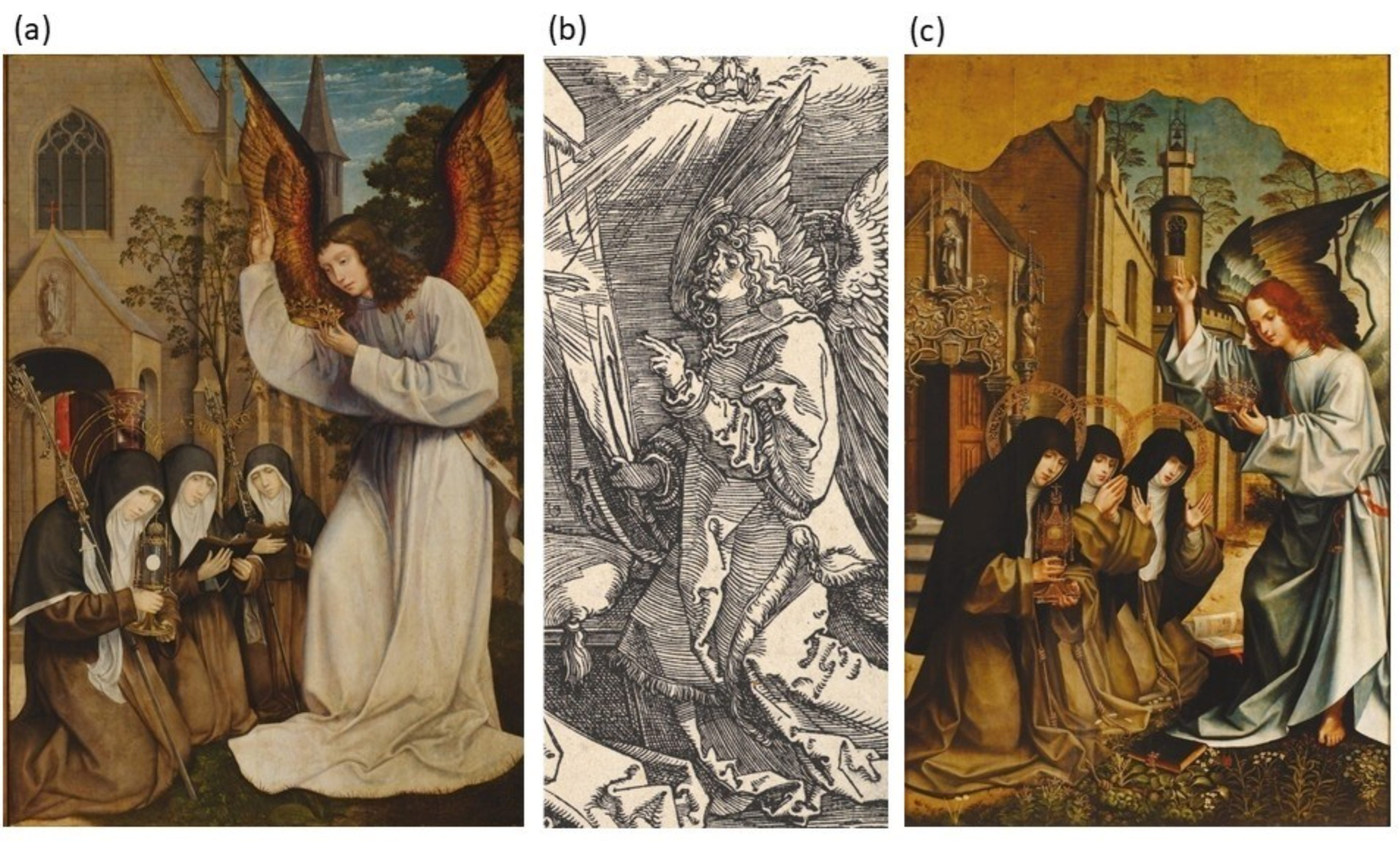

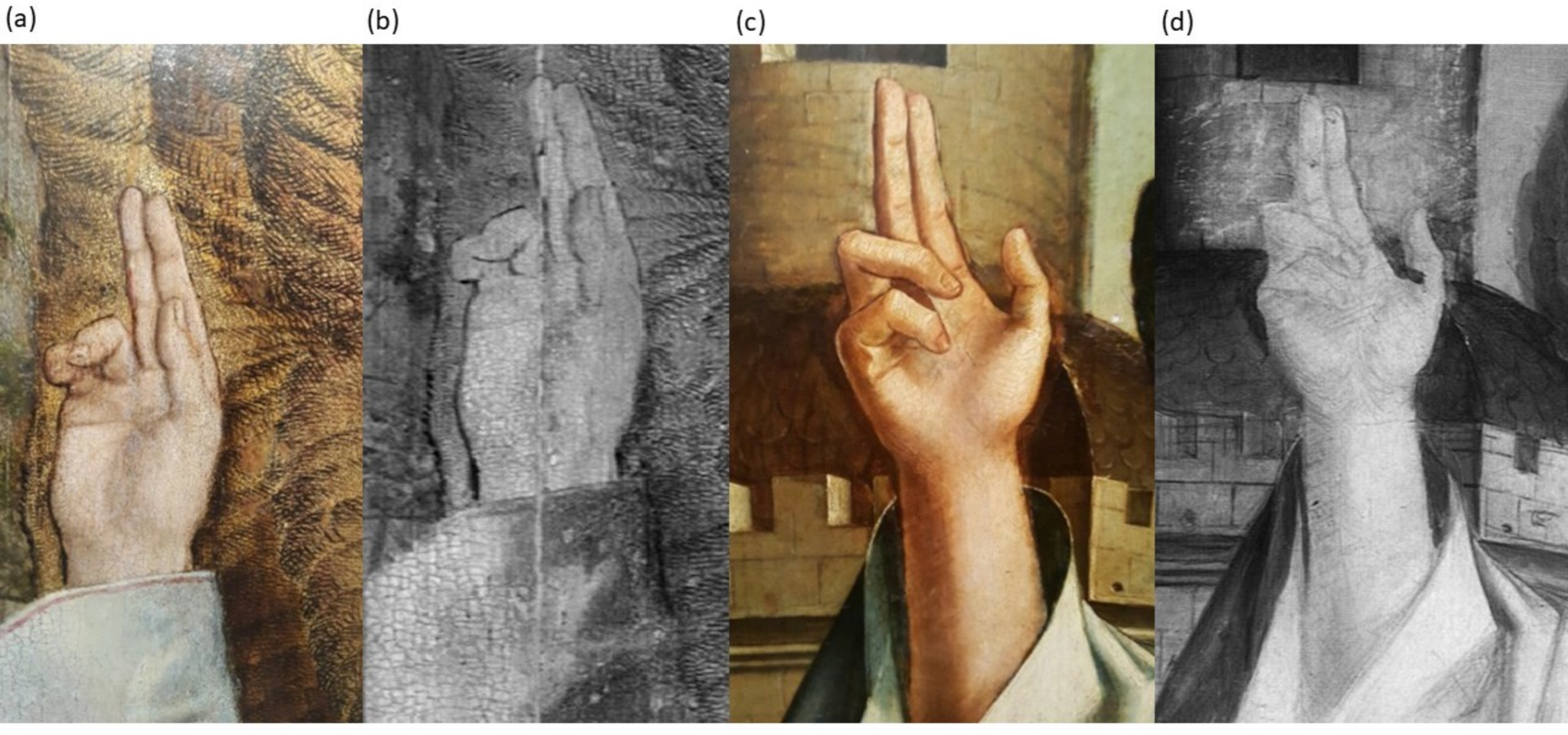
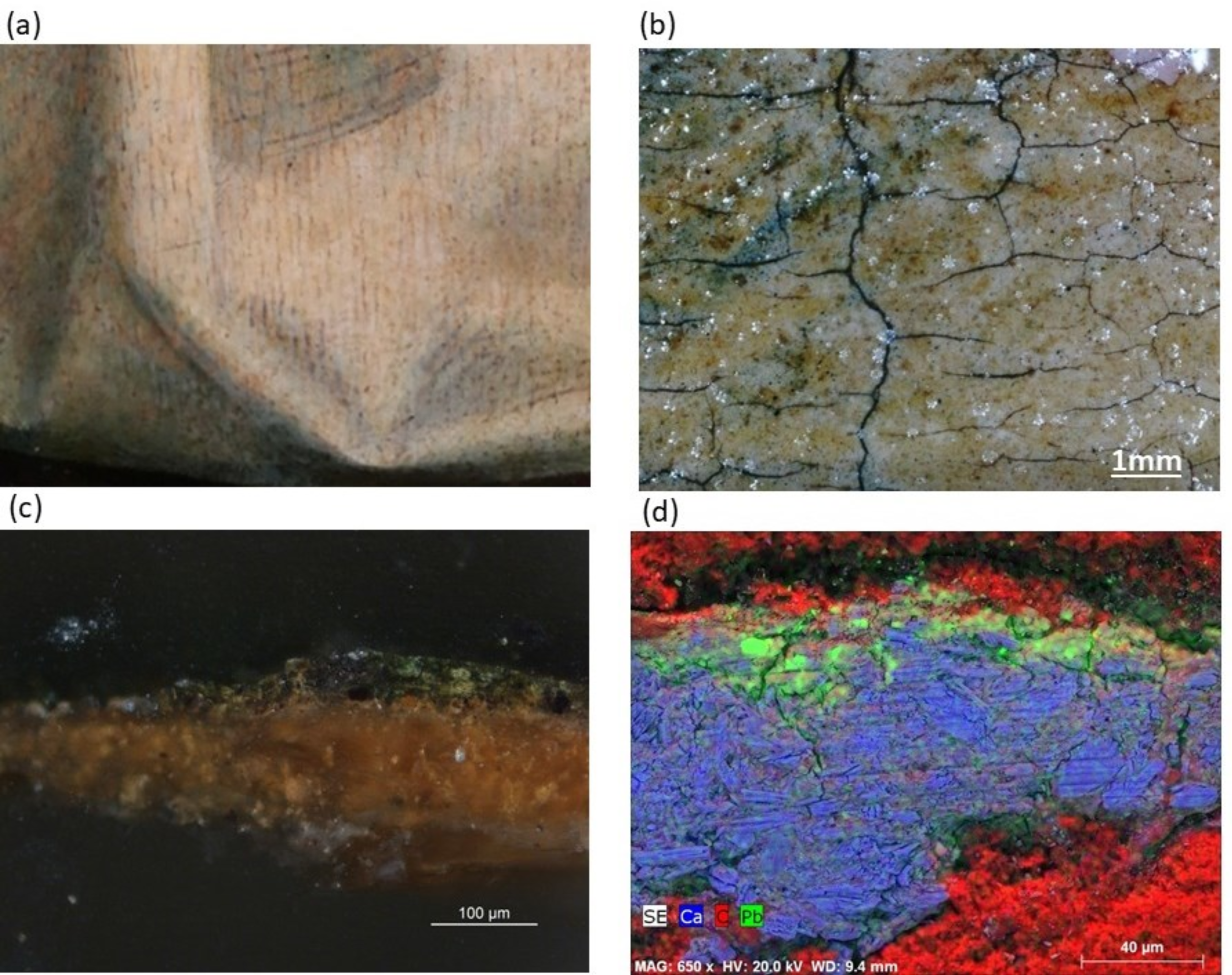
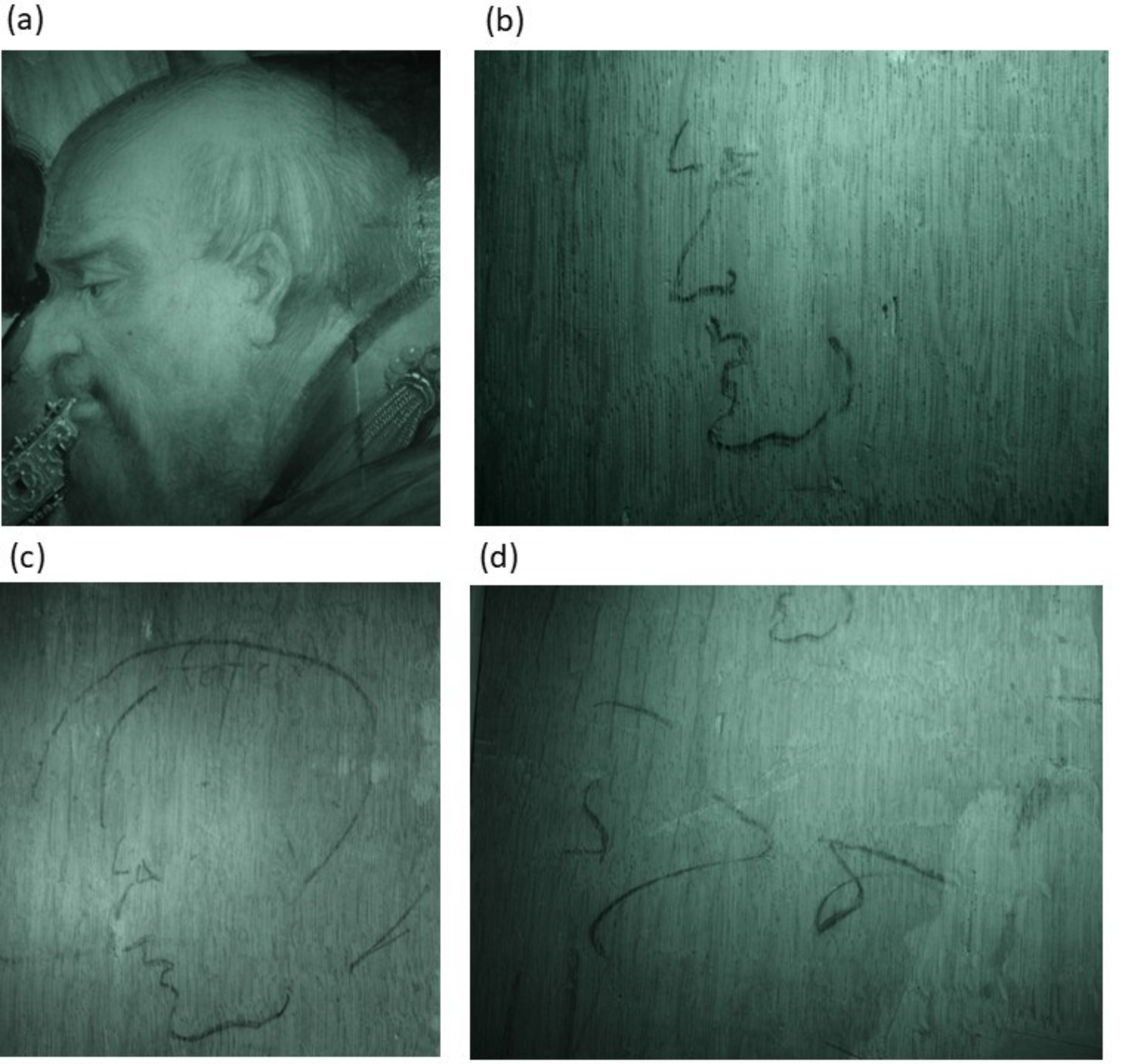
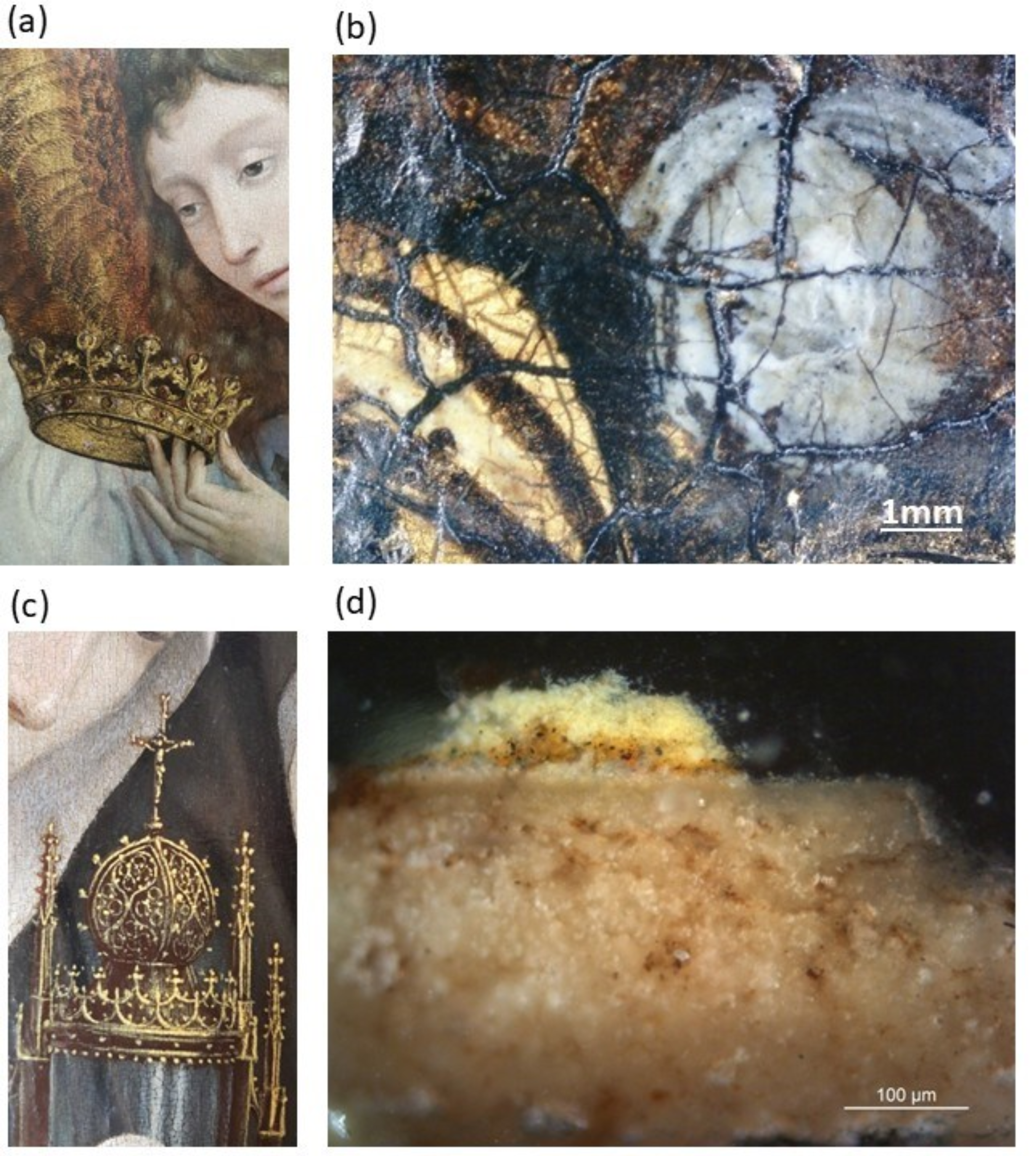
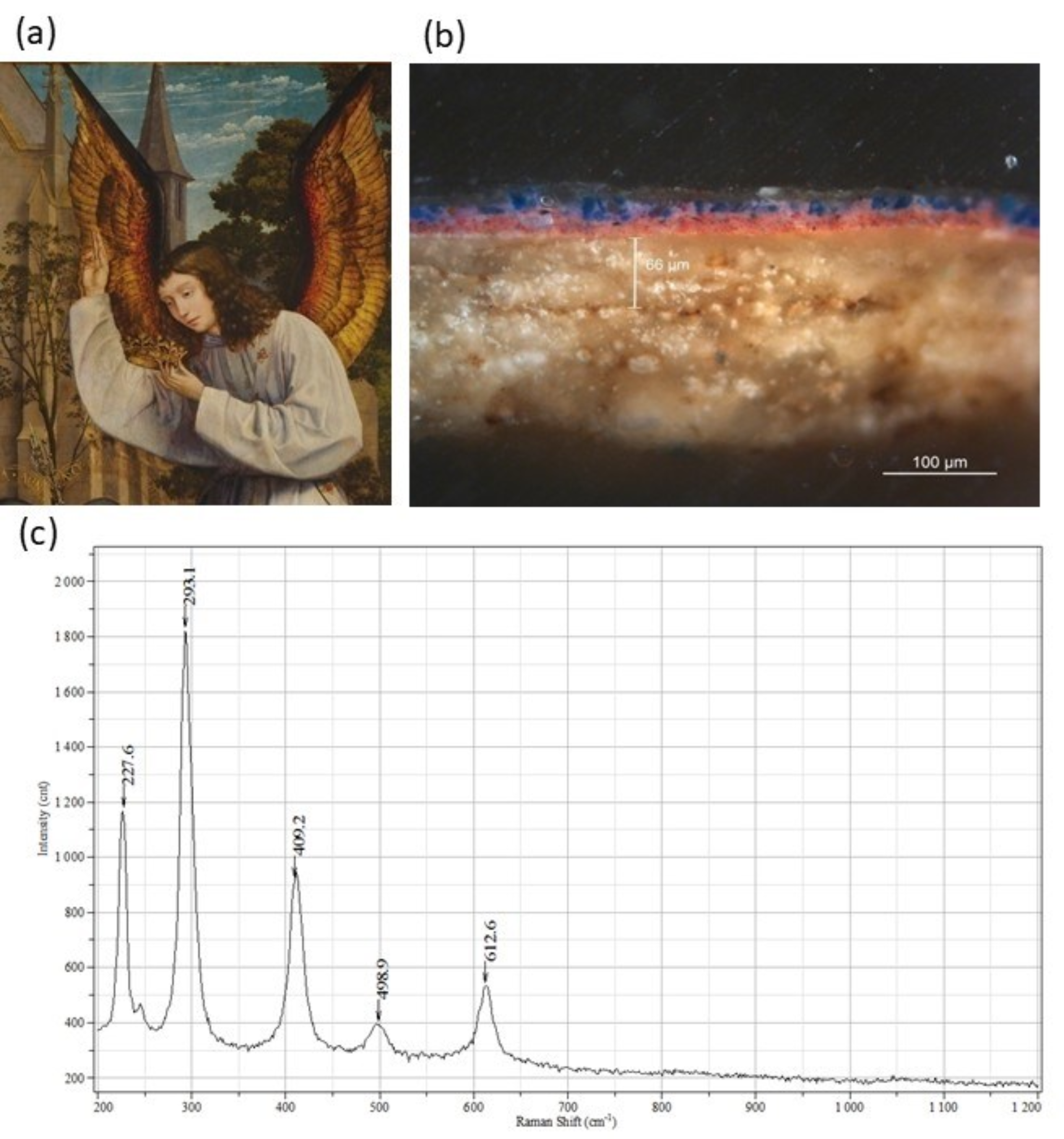

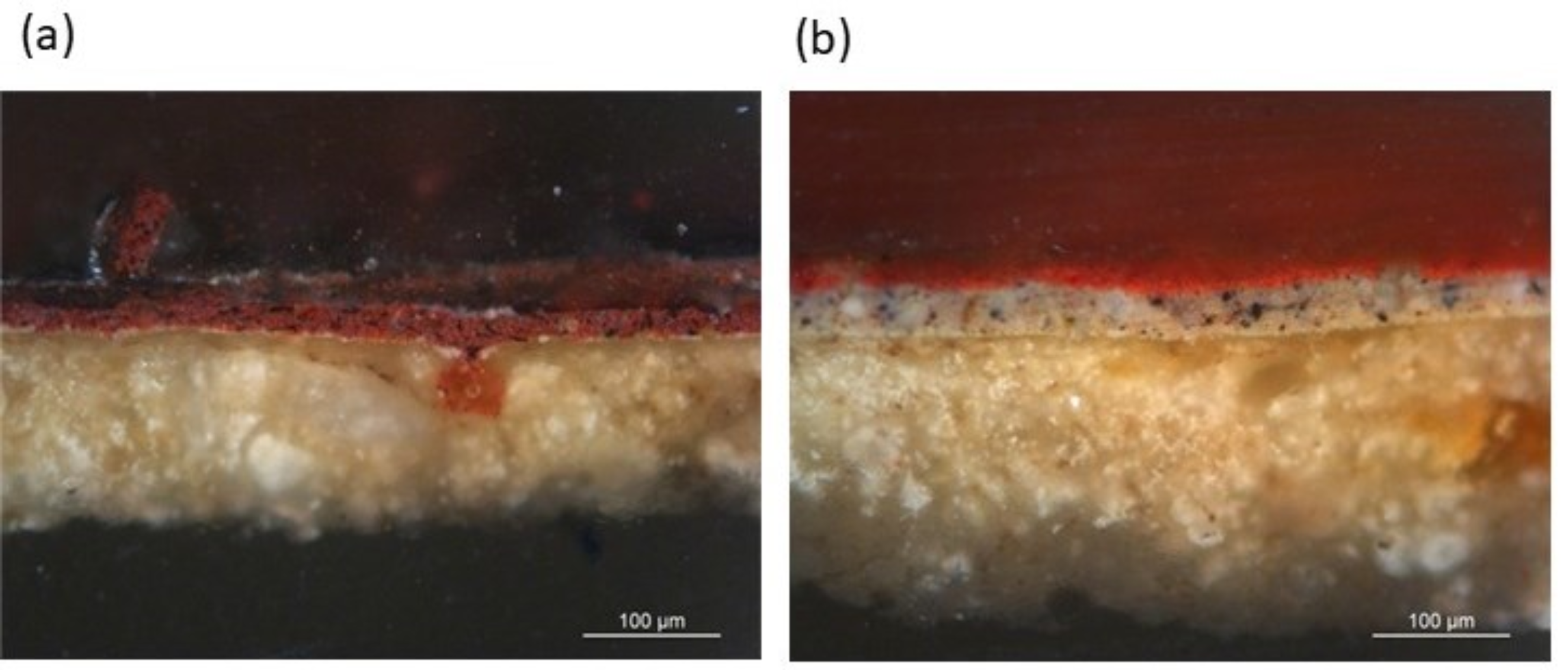
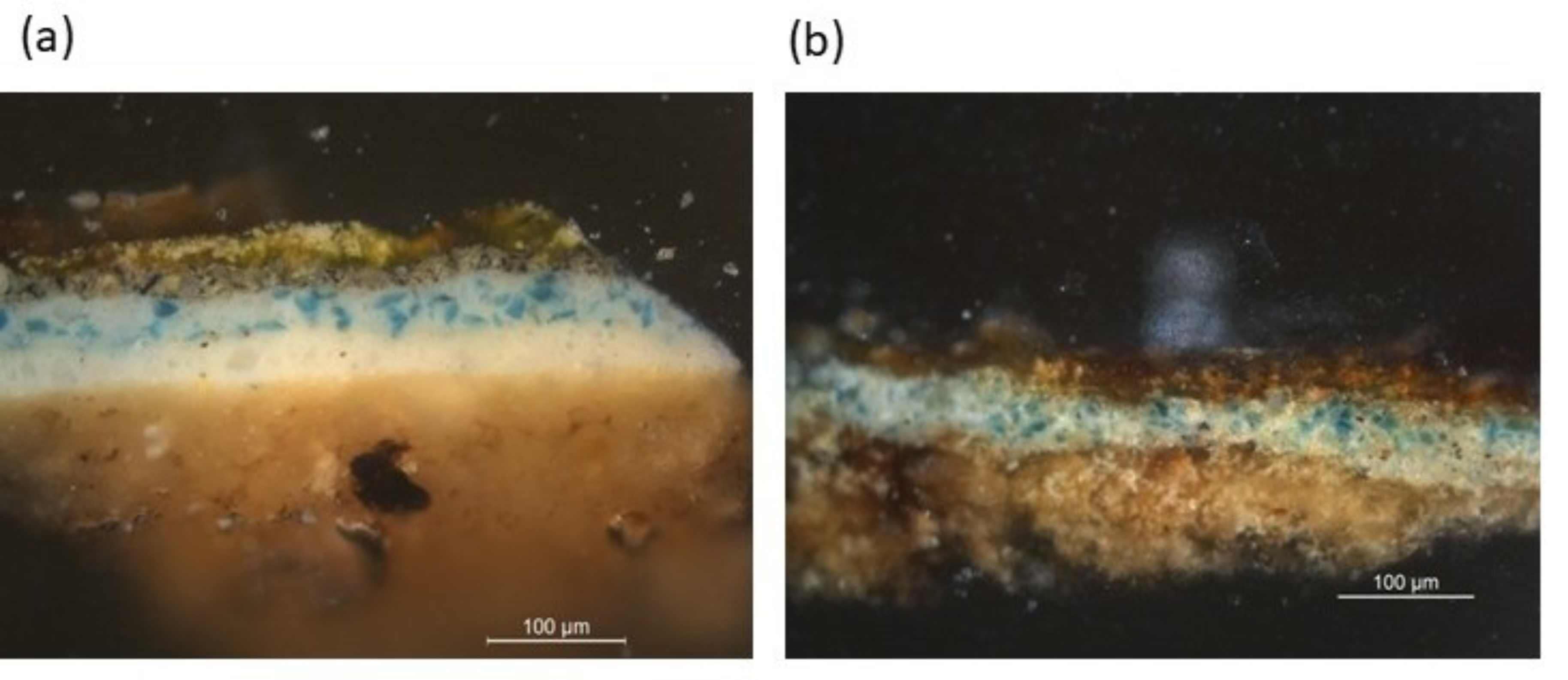
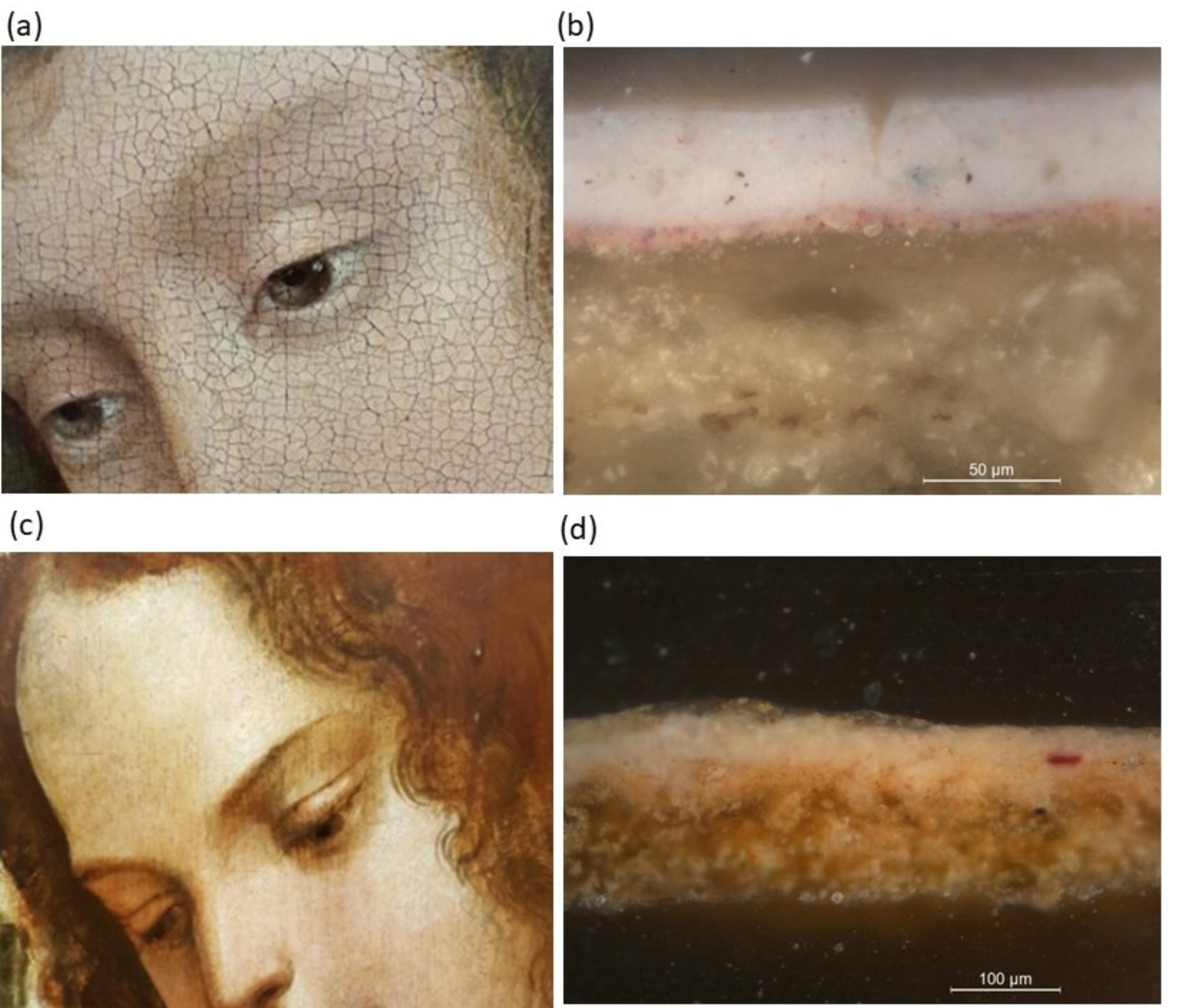
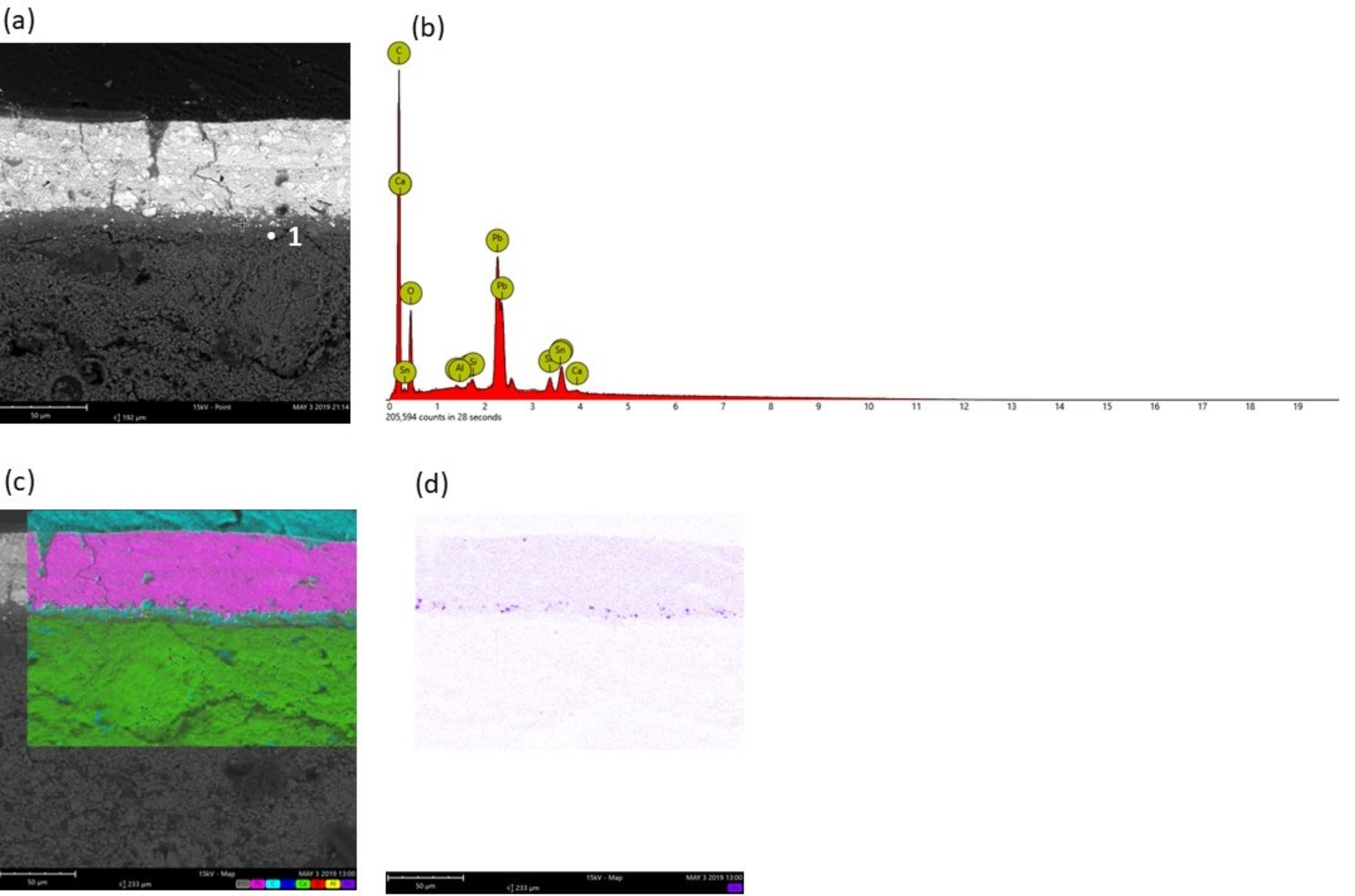
| Sample | Color/Area | Micro-Raman Key Compounds (cm−1) |
|---|---|---|
| P1-1 | white light tunic angel | ground layer: calcite (286, 1091); white layer: plumbonacrite (324, 414, 1055), hematite (228, 293, 409, 500, 613); |
| P1-2 | white angel tunic shadow | red layer: hematite (226, 294, 412, 504, 618); black layer: azurite (213, 250, 404, 771, 832, 939, 1099) |
| P1-3 | yellow light custody | yellow layer: lead-tin yellow type I (132, 160, 309, 415, 460), carbon black (1321, 1557) |
| P1-6 | ochre background shadow | brown layer: carbon black (1331, 1577), hematite (230, 297, 415), lead-tin yellow type I (130, 197, 266) |
| P1-7 | golden light angel wing | white layer: lead white (1060); bol layer: vermilion (255, 271), gold; black layer: carbon black (1336, 1585), |
| P1-10 | black wing angel | black layer: Carbon black (1361, 1616) |
| P1-12 | red shadow column | red layer: hematite (228, 247, 296, 413, 491, 611), carbon black (1346, 1600) |
| P1-13 | red mantle of the apostle in the background | white layer: lead white (1054), carbon black (1343, 1603); red layer: vermilion (254, 287, 344), |
| P1-14 | golden nimbus Sta. Clara | white layer: lead white (1054), carbon black (1325, 1608); |
| P1-15 | light brown tunic Sta.Clara | yellow layer: lead white (1056), hematite (225, 247, 291, 405, 413, 538), carbon black (1323, 1600) |
| P1-17 | light brown architecture | brown layer: lead-tin yellow type I (130, 199, 278, 293, 460, 530), lead white (1053), carbon black (1337, 1588) |
| P1-20 | brown angel hair shadow | brown layer: carbon black (1352, 1577), cinnabar (254, 294, 345), hematite (230, 297, 415); White layer: lead white (1055) |
| P1-21 | light green ground | green layer: lead-tin yellow type I (130, 159, 196, 277, 296, 459, 527), hematite (225, 292, 413, 599), carbon black (1301, 1549) |
| P1-22 | green shadow floor | carbon black (1340, 1581), goethite (258, 304, 385, 477, 547) |
| P1-23 | green light trees | blue layer: azurite (236, 280, 324, 399, 631, 763, 832, 1015, 1095), cerusite (258, 1058); green layer: plumbonacrite (130, 194, 276, 463), lead tin yellow tipe I (129, 151, 196, 268, 453), malachite (267, 352, 397, 435, 536, 612, 726, 768, 868, 939, 1007, 1095), |
| P1-24 | green shadowtrees | blue layer: azurite (278, 332, 372, 401, 593, 766, 832, 911, 1093), cerusite (213, 1056), hematite (225, 292, 413, 494, 614), |
| P1-26 | blue sky shadow | blue layer: azurite (280, 401, 536, 777, 831, 1097), barite (461, 618, 648, 989), plumbonacrite (316, 401, 1058), carbon black (1335, 1575); |
| P1-28 | gray shadow tower | yellow layer: lead tin yellow type I (130, 158, 196, 266, 456); gray layer: carbon black (1342, 1578), lead white (1052), azurite (249, 284, 394, 766, 811, 940, 1099); |
| P1-30 | black shadow veil Sta.Clara | yellow layer: lead tin yellow type I (131, 160, 196, 0276, 459), lead white (1051), carbon black (1320, 1581); black layer: carbon black (1326, 1583), red ochre (219, 285, 398, 487, 595) |
| P1-31 | carnation light hand Sta.Clara | carnation: lead-tin yellow type II (135, 216, 278, 393), lead white (1058) |
| P1-32 | hand shadow Sta.Clara | carnation: carbon black (1344, 1571), lead white (1055) |
| P1-34 | shadow angel hand | carnation: carbon black (1327, 1597), lead white (1055), hematite (225, 248, 412, 501, 610), cinnabar (255, 289, 343), |
| P1-36 | golden shadow crown | bol layer: lead tin yellow type I (128, 194, 273, 288, 453), plumbonacrite (292, 402, 1054), calcite (292, 720, 1091), hematite (222, 247, 291, 409, 494, 613), cinnabar (254, 285, 341), carbon black (1303, 1607) |
| Sample | Layer | Micro-FTIR Compounds (cm−1) |
|---|---|---|
| P1-2 | blue | Azurite (3429, 1091, 956, 839, 815, 770, 742), Cerussite (1418, 1051, 681), Oil (2926, 2852, 1705), Lead carboxylates (1539) |
| P1-7 | varnish | Ketone resin (2923, 2852, 1706, 1448) |
| bolus | Kaolinite (3698, 914), Cerussite (1051), Hydrocerussite (1045, 839, 679), Calcite (2517, 1415, 876, 712), traces of Gypsum (1621, 1108, 1005, 609), Quartz (1080, 796, 780), Ketone resin (2922, 2853, 1704, 1447), Oil (1100), Lead carboxylates (1549), Oxalates (1322) | |
| upper ground layer | Calcite (2512, 1796, 1435, 876, 713), traces of Gypsum (3409, 1619, 1112, 673, 608), traces of Hydrocerussite (1045, 839, 677), Silicates (780), Protein (2920, 2850, 1646) | |
| inferior ground layer | Calcite (2512, 1796, 1415, 875, 712), Gypsum (3402, 1620, 1119, 673), Silicates (782), Protein (2921, 2851, 1645) | |
| P1-9 | red lacquer | Hydrocerussite (1043, 839, 678), Calcite (1417, 876, 712), Gypsum (3406, 1681, 1621, 1111, 671), Silicates (779), Ketone resin (2924, 2851, 1448) |
| P1-14 | bolus | Kaolinite (3699, 3619, 914), Cerussite (1051), Hydrocerussite (3535, 1046, 839, 681), Calcite (2516, 1793, 1419, 875, 712), traces of Gypsum (3408, 1618), Oil (1726, 1100, 724), Protein (2928, 2852, 1646, 1552), Ketone resin (1709, 1447), Metal carboxylates (1529), Oxalates (1323, 780) |
| P2-2 | blue | Azurite (3428, 1091, 954, 838, 815, 770, 741), Cerussite (1052, 687), Ketone resin (2923, 2851, 1709, 1446), Metal carboxylates (1511) |
| P2-14 | bolus | Kaolinite (3699, 3650, 3620, 1034, 1010, 914), Cerussite (1050), Hydrocerussite (3527, 1409, 1045, 838, 680), Quartz (796, 780), Oil (2920, 2851, 1725, 1102, 721), Lead carboxylates (1519) |
| ground layer | Gypsum (3536, 3485, 3405, 3248, 1621, 1118, 673), Anhydrite (1015, 614), Protein (2930, 2856, 1646, 1558), Carbonate (1407) | |
| P2-30 | black | Cerussite (1406, 1051, 839, 679), Quartz (1084, 797, 780), Gypsum (3400, 1619), Ketone resin (1448, 727), Oil (2927, 2853, 1707, 1164, 722), Metal carboxylates (1545) |
| P2-32 | black | Cerussite (1051, 839, 679), Gypsum (3404, 1623, 1121, 673), Quartz (1084, 797, 780), Wax (730, 719), Ketone resin (2924, 2851, 1707, 1447), Oil (1102), Lead carboxylates (1520) |
Disclaimer/Publisher’s Note: The statements, opinions and data contained in all publications are solely those of the individual author(s) and contributor(s) and not of MDPI and/or the editor(s). MDPI and/or the editor(s) disclaim responsibility for any injury to people or property resulting from any ideas, methods, instructions or products referred to in the content. |
© 2025 by the authors. Licensee MDPI, Basel, Switzerland. This article is an open access article distributed under the terms and conditions of the Creative Commons Attribution (CC BY) license (https://creativecommons.org/licenses/by/4.0/).
Share and Cite
Antunes, V.; Candeias, A.; Mirão, J.; Valadas, S.; Cardoso, A.; Francisco, M.J.; Lauw, A.; Manso, M.; Carvalho, M.L. From Flanders to Portugal: A Portuguese Painter in Pursuit of Prestigious Flemish Painting—Materials and Techniques Compared Through an Analytical Approach. Heritage 2025, 8, 205. https://doi.org/10.3390/heritage8060205
Antunes V, Candeias A, Mirão J, Valadas S, Cardoso A, Francisco MJ, Lauw A, Manso M, Carvalho ML. From Flanders to Portugal: A Portuguese Painter in Pursuit of Prestigious Flemish Painting—Materials and Techniques Compared Through an Analytical Approach. Heritage. 2025; 8(6):205. https://doi.org/10.3390/heritage8060205
Chicago/Turabian StyleAntunes, Vanessa, António Candeias, José Mirão, Sara Valadas, Ana Cardoso, Maria José Francisco, Alexandra Lauw, Marta Manso, and Maria Luísa Carvalho. 2025. "From Flanders to Portugal: A Portuguese Painter in Pursuit of Prestigious Flemish Painting—Materials and Techniques Compared Through an Analytical Approach" Heritage 8, no. 6: 205. https://doi.org/10.3390/heritage8060205
APA StyleAntunes, V., Candeias, A., Mirão, J., Valadas, S., Cardoso, A., Francisco, M. J., Lauw, A., Manso, M., & Carvalho, M. L. (2025). From Flanders to Portugal: A Portuguese Painter in Pursuit of Prestigious Flemish Painting—Materials and Techniques Compared Through an Analytical Approach. Heritage, 8(6), 205. https://doi.org/10.3390/heritage8060205









